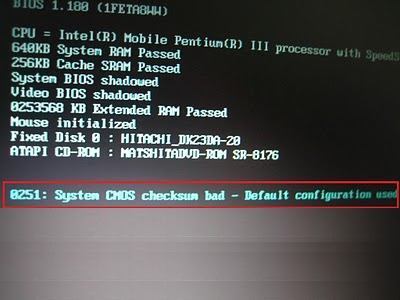CMOS Checksum Bad Error
Computer users frequently encounter CMOS Checksum Bad Error for many reasons. This error may be frustrating, but the good part is that it can be solved easily. There are very few reasons for the CMOS Checksum Bad Error, hence they can be handled effectively.
The Error Explained
A checksum is computed as an error detecting code to guard the BIOS settings stored in the CMOS memory. The CMOS Checksum Bad Error is an error that occurs when the CMOS values turn out to be incorrect. The CMOS memory stores a specific value normally to guard the BIOS software. Each time the computer is booted, this value, which is a number is checked against the stored value in the CMOS memory. If these two values are different, it causes a CMOS Checksum error message. If these values are the same, the computer boots normally.
Each computer usually deals with the CMOS Checksum Bad Error differently. Some computers warn the user and continue to boot up using settings in the CMOS, while other computers might warn the user and use the default settings in the BIOS as the correct settings and carry on with a normal boot or reboot. Usually, the strategy the computer employs is stated in the error message.
Causes of CMOS Checksum Bad Error
There are usually three main reasons that a CMOS Checksum Bad Error occurs. They include:
- CMOS Battery may not be functioning properly. The battery life may have expired.
- The user or a virus may have updated the BIOS.
- The computer may not have been shut down properly e.g. shutting off the computer’s main power without first shutting down the computer (MS Windows requires the computer to be shut down before the power is shut off).
Solutions to CMOS Checksum Bad Error
The CMOS Checksum Bad Error can be fixed easily by following the listed steps carefully.
CMOS Battery May Not be Functioning Properly
If the user suspects that the CMOS battery is not functioning properly, he/she can easily change it. Before changing the battery, reboot the computer to make sure that the error still exists. If it does, go into the CMOS and write down all of the settings. If all the settings are lost, they can usually be retrieved from the computer manufacturer. Now locate the battery and remove it. Consult the computer manual or technical support to remove your battery (the battery is flat, shiny silver colored, and coin-shaped) if needed. Take down the CMOS battery’s information such as volt, size, etc. Replace the old battery with a new one and reenter the CMOS settings. If the battery caused the CMOS Checksum Bad Error, the problem should be solved.
The BIOS May Have Been Updated
If the BIOS was recently updated, the CMOS settings may have reset. Make sure that the values entered in the BIOS are correct or simply reset them to the default settings. If a virus has updated the BIOS settings, run a virus scan and make sure that the BIOS settings are back to the default.
The Computer May Not Have Been Shut Down Properly
Sometimes when running MS Windows, if the computer is shut down without first properly shutting down the operating system, the CMOS settings will get corrupted, causing the CMOS Checksum Bad Error. Easily avoid this error by making sure that the computer is shut down properly before turning off the main power. This usually entails going into the Start Menu and clicking Turn Off Computer/ Shut Down. If improper shutdown caused the error, the issue may have been solved.



Comments - 39 Responses to “CMOS Checksum Bad Error”
Sorry but comments are closed at this time.